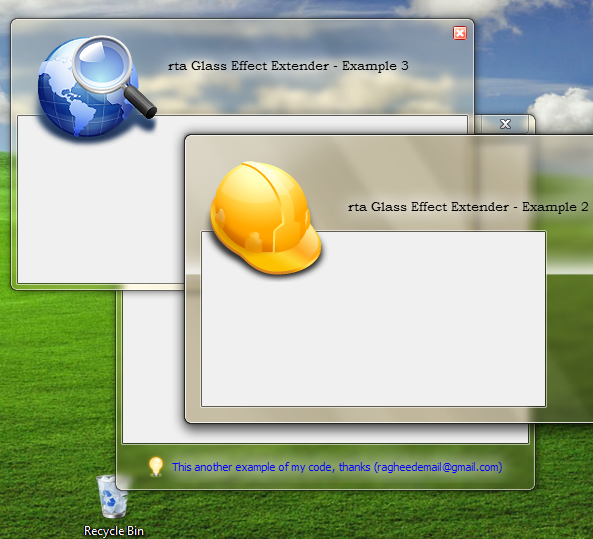使用模糊效果使标签/文本块在玻璃上可读
我正在使用WPF 3.5 SP1,我希望实现类似的功能(玻璃部件已经完成):
http://lh3.ggpht.com/_0B12UOQNmgU/SwPqI4FcYaI/AAAAAAAAASM/HKFPyZ9uX3o/Aero%20Glass.jpg
(Source)

(Source)
你可以在文本周围看到漂亮的模糊,这使它非常易读。我还发现正确的方法是使用API DrawThemeTextEx,它使用推荐的系统选项渲染模糊。但是,如何使用WPF实现相同的效果?
我能够找到包含有用资源的链接:
How to make WPF text on Aero glass background readable?
Glowing Label Controls On A Glass Surface
他们通过复制TextBlock并在其上设置模糊效果来实现。但是,这不是一个真正的解决方案。这是它的样子:
http://i53.tinypic.com/2ly67nq.png
将结果效果与上面的图像进行比较,您将看到解决方案仍然很遥远。那么如何使用WPF正确获得所需的效果呢?我对仿真很好(不使用DrawThemeTextEx API),只要结果非常相似。
谢谢。
4 个答案:
答案 0 :(得分:7)
<TextBlock ...>
<TextBlock.Effect>
<DropShadowEffect BlurRadius="10" Color="White" ShadowDepth="0" />
</TextBlock.Effect>
</TextBlock>
答案 1 :(得分:7)
根据Luke的要求,我为XAML s添加了Decorator:
<Decorator>
<Decorator.Effect>
<DropShadowEffect BlurRadius="7" Color="White" ShadowDepth="0" />
</Decorator.Effect>
<Decorator>
<Decorator.Effect>
<DropShadowEffect BlurRadius="7" Color="White" ShadowDepth="0" />
</Decorator.Effect>
<Decorator>
<Decorator.Effect>
<DropShadowEffect BlurRadius="7" Color="White" ShadowDepth="0" />
</Decorator.Effect>
<ContentPresenter ContentTemplate="{TemplateBinding ContentTemplate}"
Content="{TemplateBinding Content}" ContentStringFormat="{TemplateBinding ContentStringFormat}"
HorizontalAlignment="{TemplateBinding HorizontalContentAlignment}" RecognizesAccessKey="True"
VerticalAlignment="{TemplateBinding VerticalContentAlignment}" />
</Decorator>
</Decorator>
</Decorator>
我使用前面提到的XAML为ControlTemplate创建了一个Label,并在我需要文本发光的任何地方使用它。
答案 2 :(得分:2)
在这些行中你的文字后面有一个矩形略微模糊的东西怎么样,我已经使用了几次。我发现它使它更具可读性,因为模糊覆盖了更大的区域。
<Grid>
<Rectangle Fill="#8FFFFFFF"
Stroke="{x:Null}"
StrokeThickness="0"
VerticalAlignment="Center"
Width="{Binding ActualWidth, ElementName=PART_Title, Mode=Default}"
Height="{Binding ActualHeight, ElementName=PART_Title, Mode=Default}"
RadiusX="2"
RadiusY="2">
<Rectangle.Effect>
<BlurEffect Radius="10" />
</Rectangle.Effect>
</Rectangle>
<TextBlock x:Name="PART_Title"
Text="{Binding Title}"
Foreground="Black"
TextWrapping="NoWrap"
TextTrimming="CharacterEllipsis" />
</Grid>
答案 3 :(得分:1)
我在Paya的答案中实现装饰器时遇到了麻烦,所以我展示了如何将它包装成一个完整的,随时可用的样式资源,可以应用于任何标签,这将显示玻璃效果,并且在禁用时也会使标签变暗并保留对齐,边框等:
<Style x:Key="GlassLabelStyle" TargetType="{x:Type Label}">
<Setter Property="Template">
<Setter.Value>
<ControlTemplate TargetType="{x:Type Label}">
<Border BorderBrush="{TemplateBinding BorderBrush}"
BorderThickness="{TemplateBinding BorderThickness}"
Background="{TemplateBinding Background}"
Padding="{TemplateBinding Padding}" SnapsToDevicePixels="True">
<Grid>
<Decorator>
<Decorator.Effect>
<DropShadowEffect BlurRadius="7" Color="White" ShadowDepth="0" />
</Decorator.Effect>
<Decorator>
<Decorator.Effect>
<DropShadowEffect BlurRadius="7" Color="White" ShadowDepth="0" />
</Decorator.Effect>
<Decorator>
<Decorator.Effect>
<DropShadowEffect BlurRadius="7" Color="White" ShadowDepth="0" />
</Decorator.Effect>
<ContentPresenter ContentTemplate="{TemplateBinding ContentTemplate}"
Content="{TemplateBinding Content}" ContentStringFormat="{TemplateBinding ContentStringFormat}"
HorizontalAlignment="{TemplateBinding HorizontalContentAlignment}" RecognizesAccessKey="True"
SnapsToDevicePixels="{TemplateBinding SnapsToDevicePixels}"
VerticalAlignment="{TemplateBinding VerticalContentAlignment}">
</ContentPresenter>
</Decorator>
</Decorator>
</Decorator>
</Grid>
</Border>
<ControlTemplate.Triggers>
<Trigger Property="IsEnabled" Value="False">
<Setter Property="Foreground" Value="{DynamicResource {x:Static SystemColors.GrayTextBrushKey}}"/>
<Setter Property="Opacity" Value="0.5"/>
</Trigger>
</ControlTemplate.Triggers>
</ControlTemplate>
</Setter.Value>
</Setter>
</Style>
如果样式位于您的窗口或应用资源中,那么您可以像这样应用它:
<Label Style="{StaticResource GlassLabelStyle}"
虽然我在使用它时,我也遇到了TextBox的问题,当控件被禁用时它根本无法改变背景颜色(它只是保持恢复为白色)所以有人发现你必须覆盖整个模板!见(https://stackoverflow.com/a/3752517/88409)。因此,这是一个随时可用的样式,可以在禁用时使文本框保持半透明(在玻璃上看起来很棒),并且在启用时将使其背景为半透明白色,边框更明显:
<SolidColorBrush x:Key="DisabledBackgroundBrush" Color="#01000000" />
<SolidColorBrush x:Key="DisabledBorderBrush" Color="#40000000" />
<SolidColorBrush x:Key="DisabledForegroundBrush" Color="#88ffffff" />
<Style x:Key="TextBoxStyle" TargetType="{x:Type TextBox}">
<Setter Property="Background" Value="#88ffffff"/>
<Setter Property="BorderBrush" Value="Black"/>
<Setter Property="Template">
<Setter.Value>
<ControlTemplate TargetType="TextBox">
<Border Name="Bd" BorderThickness="{TemplateBinding BorderThickness}"
BorderBrush="{TemplateBinding BorderBrush}"
Background="{TemplateBinding Background}"
SnapsToDevicePixels="true">
<ScrollViewer Name="PART_ContentHost" Background="{TemplateBinding Background}"
SnapsToDevicePixels="{TemplateBinding SnapsToDevicePixels}" />
</Border>
<ControlTemplate.Triggers>
<Trigger Property="IsEnabled" Value="False">
<Setter Value="{StaticResource DisabledBackgroundBrush}" Property="Background" />
<Setter Value="{StaticResource DisabledBorderBrush}" Property="BorderBrush"/>
<Setter Value="{StaticResource DisabledForegroundBrush}" Property="Foreground" />
<Setter TargetName="PART_ContentHost" Property="Background" Value="{StaticResource DisabledBackgroundBrush}"/>
<Setter TargetName="PART_ContentHost" Property="BorderBrush" Value="{StaticResource DisabledBackgroundBrush}"/>
</Trigger>
</ControlTemplate.Triggers>
</ControlTemplate>
</Setter.Value>
</Setter>
</Style>
- 我写了这段代码,但我无法理解我的错误
- 我无法从一个代码实例的列表中删除 None 值,但我可以在另一个实例中。为什么它适用于一个细分市场而不适用于另一个细分市场?
- 是否有可能使 loadstring 不可能等于打印?卢阿
- java中的random.expovariate()
- Appscript 通过会议在 Google 日历中发送电子邮件和创建活动
- 为什么我的 Onclick 箭头功能在 React 中不起作用?
- 在此代码中是否有使用“this”的替代方法?
- 在 SQL Server 和 PostgreSQL 上查询,我如何从第一个表获得第二个表的可视化
- 每千个数字得到
- 更新了城市边界 KML 文件的来源?